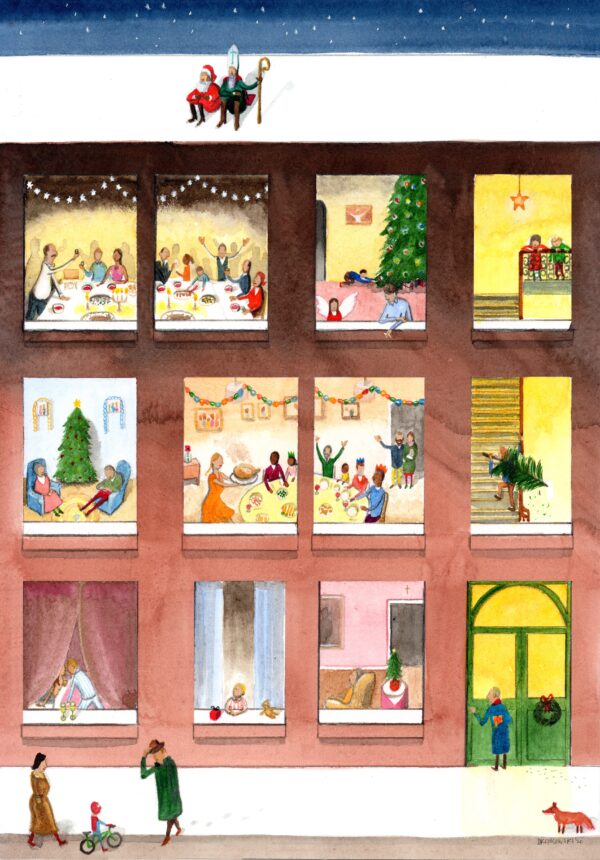One of the benefits of a Pole marrying someone British is that the logistics of which family to visit at Christmas are easily solved by the two traditional celebrations on Christmas Eve and Christmas Day.
 I have always celebrated Wigilia (the traditional Christmas Eve meal), and my childhood memories are of long tables made even longer to accommodate extra relatives coming from far and distant lands. Everyone would be smartly dressed and the table would be immaculately prepared (even if the extra chairs were all different heights). Usually the eldest in the room would say a few words before passing round the opłatek (host) which everyone would share while wishing one another good luck for the new year. This year will be different due to the pandemic, but Wigilia will go ahead nevertheless, albeit in a more modest fashion. Most traditions will remain, including:
I have always celebrated Wigilia (the traditional Christmas Eve meal), and my childhood memories are of long tables made even longer to accommodate extra relatives coming from far and distant lands. Everyone would be smartly dressed and the table would be immaculately prepared (even if the extra chairs were all different heights). Usually the eldest in the room would say a few words before passing round the opłatek (host) which everyone would share while wishing one another good luck for the new year. This year will be different due to the pandemic, but Wigilia will go ahead nevertheless, albeit in a more modest fashion. Most traditions will remain, including:
– wódka, plenty of it. To go with the śledzie (raw herring). Drinking a little, but often makes for a jolly atmosphere and helps with carol singing later.
– barszcz, paszteciki, potato and vegetable salad are the stalwarts of what traditionally should be 14 courses. My Babcia will usually make jellied carp. There are stories that in Poland, where I lived until I was 5, people would keep live carp in their bathtubs until the evening but I can’t confirm I ever saw one.
– heated conversation, usually around religion, politics, football, popular culture, and most recently Brexit. Although this is not particular to Polish families at Christmas, we can at least get it all out of the way before Christmas Day.
– opening presents. As a child, the limbo between finishing the meal and staggering over to the tree to sing carols and open presents was excruciatingly long and boring. As an adult I now enjoy this slow coffee interval.
– the conversation about Midnight Mass. Shall we go now and save having to go tomorrow? Or shall we have some more makowiec and go to church in the morning? The morning Mass is guaranteed to have least one child wearing their new Spiderman costume, whereas the singing is always louder at midnight.
As a consequence, Christmas Day is fairly relaxed. It’s the second half of a match which you’re already winning 3-0. That’s not to say we’re complacent. I enjoy dreaming about the traditional Christmas Day breakfast but I never get up in time to have one. We have stockings at the end of our bed for extra presents from Father Christmas, and we try to keep the clementine to chocolate ratio on the healthy side. If we have it at home, as we will this year, I will spend the morning making an elaborate chart of what goes in the oven at what time. We have turkey with all the trimmings as everyone loves something different. The food, all on a plate, mostly meat and roasted vegetables, complements the smaller, staggered courses of Baltic cuisine from the night before, and so the two celebrations are an ideal marriage.
I am very lucky to have these two traditions, as are my children and many Poles living here, and I am grateful to have been able to observe my older relatives prepare and explain dishes and customs so that I can carry them on. The two different celebrations will always have their unique traditions but it is their kinship which makes Christmas truly special for me.
(The painting features a typical Wigilia on the top floor in the evening, including the sharing of the opłatek, raising a toast, and leaving an extra empty chair for the ‘uninvited guest’. On the floor below, during the following day, a Christmas Day lunch with turkey and paper hats. Various other stories are going on around the picture, including Father Christmas and the traditional Święty Mikołaj sharing a well-earned rest on the roof).










![Czy to możliwe? Laxton Hall po raz szesnasty! [ZDJĘCIA]](https://www.tydzien.co.uk/wp-content/themes/LondonLive/thumb.php?src=/media/2024/06/Głowne-zdjęcie-do-artykułu-nr-3-600x400.jpg&w=95&h=74&zc=1&q=100)



